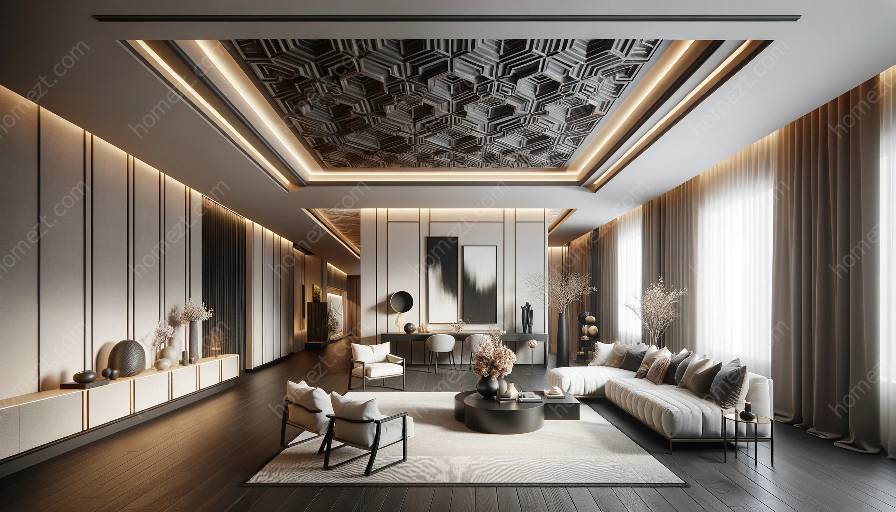Are you looking to transform your space with a striking and unique design feature? One way to achieve this is by creating a statement ceiling that beautifully complements the architectural style of your home. A statement ceiling can add a sense of drama and character to a room, becoming a focal point that enhances the overall aesthetic. Whether you’re working with a modern, traditional, or eclectic architectural style, there are several design considerations and techniques to achieve a harmonious balance. Let’s explore how to design a statement ceiling that harmonizes with a variety of architectural styles.
Modern Architecture
In a modern architectural setting, clean lines, minimalism, and a focus on open spaces are key design elements. When creating a statement ceiling in a modern space, it’s essential to align with these characteristics while adding a touch of visual interest. One approach is to incorporate geometric patterns or textures that complement the sleek and contemporary ambiance. Consider using materials such as exposed metal beams, recessed lighting, or minimalist coffered designs to create a sense of depth and sophistication.
Enhancing Modern Spaces
To enhance the modern appeal, choose a statement ceiling that embraces simplicity and functionality. Utilize monochromatic color palettes and integrate hidden lighting fixtures for a seamless and illuminated effect. Keep the design streamlined and uncluttered, focusing on creating a visually impactful feature that complements the overall modern aesthetic of the space.
Traditional Architecture
For homes with traditional architectural styles, such as Colonial, Victorian, or Craftsman, a statement ceiling can enhance the timeless elegance and charm of the space. Incorporating elements such as decorative molding, coffered ceilings, or intricate wood paneling can accentuate the classic and refined qualities of traditional architecture. Consider using rich, warm tones and ornate details to evoke a sense of old-world grandeur and sophistication.
Embracing Timeless Beauty
When designing a statement ceiling in a traditional setting, emphasize the craftsmanship and details that reflect the historical and cultural aspects of the architectural style. Intricate patterns, ornamental plasterwork, and embellished trim can contribute to a sense of luxury and opulence. Choose classic lighting fixtures, such as elegant chandeliers or traditional sconces, to further complement the overall traditional ambiance.
Eclectic and Transitional Spaces
For spaces that blend various architectural styles or have a transitional design approach, the opportunity to create a statement ceiling becomes even more versatile. Embrace the fusion of different elements by combining modern and traditional influences in the ceiling design. This could involve incorporating unexpected materials, bold color schemes, or unconventional patterns to achieve a one-of-a-kind look that harmonizes with the eclectic nature of the space.
Expressing Individuality
In eclectic and transitional spaces, the statement ceiling can serve as a platform for expressing individuality and creativity. Embrace the freedom to mix and match different design elements, such as antique beams with contemporary lighting or vibrant murals with industrial accents. The goal is to establish a sense of cohesive diversity that showcases the blending of architectural styles in a visually compelling manner.
Decorating and Accentuating the Statement Ceiling
Once the statement ceiling design aligns with the architectural style of the space, it’s important to consider how to further enhance its visual impact through decorating and accentuating. This can involve choosing complementary wall treatments, such as textured wallpapers or accent colors, that highlight the statement ceiling. Additionally, strategically placing furniture, artwork, or hanging fixtures can draw attention to the ceiling and create a sense of balance and harmony within the space.
Lighting Considerations
Lighting plays a crucial role in accentuating a statement ceiling. Incorporate lighting fixtures that direct attention upward, such as recessed lights, pendant lamps, or uplighting, to emphasize the architectural details and textures. Use lighting to create a captivating interplay of light and shadow, enhancing the overall visual interest of the statement ceiling.
Conclusion
Designing a statement ceiling that complements different architectural styles requires a thoughtful approach that respects the inherent design characteristics of each style. By understanding the key elements of modern, traditional, and eclectic architectural styles, as well as the various design techniques and considerations, you can create a statement ceiling that becomes an integral part of the overall aesthetic and elevates the visual appeal of the space.






































